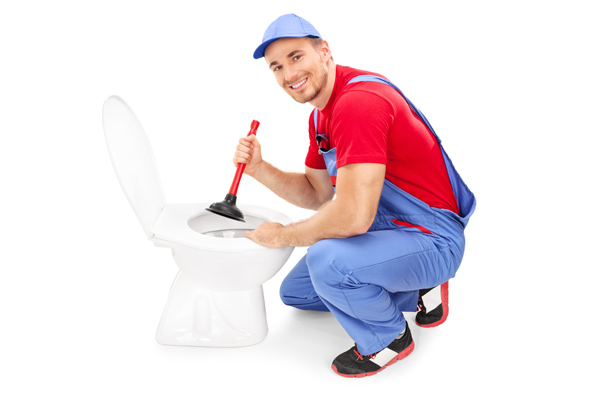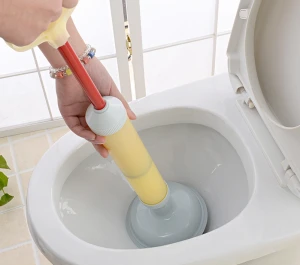Applying Plunger and Drain Cleaners: Professional Tips
Applying Plunger and Drain Cleaners: Professional Tips
Blog Article
Were you in search of facts about How To Use Your Toilet Plunger Correctly in 5 Easy Steps?

Intro
Proper upkeep of house drains pipes is necessary for stopping obstructions and ensuring smooth water circulation. One of the secret devices in every house owner's toolkit is the bettor, along with numerous drain cleaners developed to deal with persistent obstructions properly. This article explores how to use plungers and drainpipe cleansers successfully to keep your drains pipes moving openly.
Area 1: Comprehending Bettors
Sorts of Plungers
There are a number of kinds of bettors offered, each designed for different kinds of drains pipes and obstructs. One of the most common types include cup plungers, flange plungers, and accordion bettors.
Exactly How Plungers Work
Bettors work with the principle of developing pressure and suction to displace obstructions. When appropriately used over a drainpipe, they produce a vacuum cleaner that can take out particles or separate obstructions.
Selecting the Right Bettor
Picking the right plunger depends on the sort of drain and the nature of the obstruction. Cup bettors are perfect for sinks and tubs, while flange bettors are much better suited for toilets because of their design.
Common Blunders with Plungers
Preventing these errors makes certain effective plunging: inappropriate seal around the drainpipe, not enough force, and unclear bordering particles.
Section 2: Utilizing Plungers Successfully
Preparation
Prior to diving, guarantee the bettor covers the drainpipe entirely and develops a tight seal. Clear any type of visible debris around the drain opening.
Method
Beginning with mild diving motions to construct suction. Increase stress slowly, utilizing a stable rhythm. Repeat as essential until the drain gets rid of.
Troubleshooting Tips
If plunging doesn't function, attempt adjusting the seal, using petroleum jelly for a far better seal, or making use of a various type of plunger.
Area 3: Understanding Drain Cleansers
Types of Drainpipe Cleaning Company
Drain pipes cleansers can be chemical or enzymatic. Chemical cleaners make use of strong chemicals to liquify clogs, while chemical cleaners make use of all-natural enzymes to break down raw material.
Exactly How Drainpipe Cleansers Job
Chemical cleaners react with blockages to dissolve them, while enzymatic cleaners break down organic products like hair and oil without harming pipelines.
Security Considerations
Always use handwear covers and eye security when making use of chemical drain cleansers. Ensure adequate ventilation and comply with producer instructions very carefully.
Eco-Friendly Alternatives
Consider making use of vinegar and cooking soft drink or enzyme-based cleaners for environment-friendly options that are more secure for pipes and the atmosphere.
Area 4: Making Use Of Drain Cleaners Properly
Application Strategies
Put chemical cleansers directly into the drainpipe opening. Permit them to benefit the suggested time before purging with warm water. Enzymatic cleaners ought to sit over night.
Preventative measures
Stay clear of mixing different kinds of cleaners, as this can generate poisonous fumes. Never use chemical cleaners in conjunction with a bettor, as spilling can occur.
Taking Care Of Stubborn Blockages
For relentless obstructions, think about using a pipes serpent or calling a specialist plumbing professional to prevent damages to pipes.
Verdict
Finally, understanding how to make use of bettors and drain cleaners effectively is vital for maintaining healthy and balanced plumbing systems. By selecting the right tools and methods, property owners can take on minor blockages and protect against major plumbing issues down the line.
How To Properly Use A Plumbing Snake To Clear Drains
When any drain clogs in our home arise, we tend to gravitate toward the plunger and little else. In cases where the plunger and its vacuum-created pressure are not able to clear clogs, many immediately move to harmful chemicals or simply call their plumber to fix the issue.
we’re happy to help with all drain cleaning needs and concerns. This includes informing you on a few other home remedies you may have at your disposal for minor to moderate clogs, one of which is the use of a plumbing snake. Many people have never used one of these before – let’s go over the steps to take when your drain clogs and you have a plumbing snake available.
Attempt Plunger Use
The first step here, as we noted above, should indeed be to grab your plunger when you notice a drain clog and attempt to resolve it this way. If you’re unsure how to use a particular type of plunger, our plumbers can answer any questions you have. If this doesn’t do the trick, however, you move on to the snake.
Locate And Prepare Snake
A plumbing snake is a metal or plastic device that’s generally about a quarter of an inch thick. It’s design with significant extensions, meant to reach down into your clogged drain and push the clog out. Snakes also contain drain augers that will latch onto and push stubborn blockages.
If your plunger doesn’t clear a clog, locate your snake and bring it to the drain in question. We also recommend keeping a bucket nearby to collect the clog once you pull it out, plus we’d advise wearing goggles and possibly protective gloves.
Feed Snake
Once you’re ready to go, feed the snake slowly down the drain, using the crank device it comes with to keep it moving until it finds the clog. Once this happens, much of the clog will be latched onto the coil so you can pull it out, while the rest will simply break up and flow downward.
Detach Debris
Remove the snake slowly from the drain, and once you’ve done so, pick off any debris that’s stuck to the coil. This is another area where wearing gloves is a must.
Flush Drain
Finally, take a few minutes to ensure the snake has done its job correctly. If you’ve been using it on a toilet, flush the toilet a couple times and make sure everything flows well. If you’ve used it on a different drain, flush it with some room temperature water.
https://www.mybuddytheplumber.com/blog/how-to-properly-use-a-plumbing-snake-to-clear-drains/

Application Strategies
Put chemical cleansers directly into the drainpipe opening. Permit them to benefit the suggested time before purging with warm water. Enzymatic cleaners ought to sit over night.
Preventative measures
Stay clear of mixing different kinds of cleaners, as this can generate poisonous fumes. Never use chemical cleaners in conjunction with a bettor, as spilling can occur.
Taking Care Of Stubborn Blockages
For relentless obstructions, think about using a pipes serpent or calling a specialist plumbing professional to prevent damages to pipes.
Verdict
Finally, understanding how to make use of bettors and drain cleaners effectively is vital for maintaining healthy and balanced plumbing systems. By selecting the right tools and methods, property owners can take on minor blockages and protect against major plumbing issues down the line.
How To Properly Use A Plumbing Snake To Clear Drains
When any drain clogs in our home arise, we tend to gravitate toward the plunger and little else. In cases where the plunger and its vacuum-created pressure are not able to clear clogs, many immediately move to harmful chemicals or simply call their plumber to fix the issue.
we’re happy to help with all drain cleaning needs and concerns. This includes informing you on a few other home remedies you may have at your disposal for minor to moderate clogs, one of which is the use of a plumbing snake. Many people have never used one of these before – let’s go over the steps to take when your drain clogs and you have a plumbing snake available.
Attempt Plunger Use
The first step here, as we noted above, should indeed be to grab your plunger when you notice a drain clog and attempt to resolve it this way. If you’re unsure how to use a particular type of plunger, our plumbers can answer any questions you have. If this doesn’t do the trick, however, you move on to the snake.
Locate And Prepare Snake
A plumbing snake is a metal or plastic device that’s generally about a quarter of an inch thick. It’s design with significant extensions, meant to reach down into your clogged drain and push the clog out. Snakes also contain drain augers that will latch onto and push stubborn blockages.
If your plunger doesn’t clear a clog, locate your snake and bring it to the drain in question. We also recommend keeping a bucket nearby to collect the clog once you pull it out, plus we’d advise wearing goggles and possibly protective gloves.
Feed Snake
Once you’re ready to go, feed the snake slowly down the drain, using the crank device it comes with to keep it moving until it finds the clog. Once this happens, much of the clog will be latched onto the coil so you can pull it out, while the rest will simply break up and flow downward.
Detach Debris
Remove the snake slowly from the drain, and once you’ve done so, pick off any debris that’s stuck to the coil. This is another area where wearing gloves is a must.
Flush Drain
Finally, take a few minutes to ensure the snake has done its job correctly. If you’ve been using it on a toilet, flush the toilet a couple times and make sure everything flows well. If you’ve used it on a different drain, flush it with some room temperature water.
https://www.mybuddytheplumber.com/blog/how-to-properly-use-a-plumbing-snake-to-clear-drains/

As an enthusiastic reader on Here's How to Correctly Use a Toilet Plunger, I figured sharing that excerpt was a smart idea. Are you aware of another person who is excited about the topic? Take a moment to share it. We treasure reading our article about A Guide to Plungers (and How to Use Them).
About This Report this page